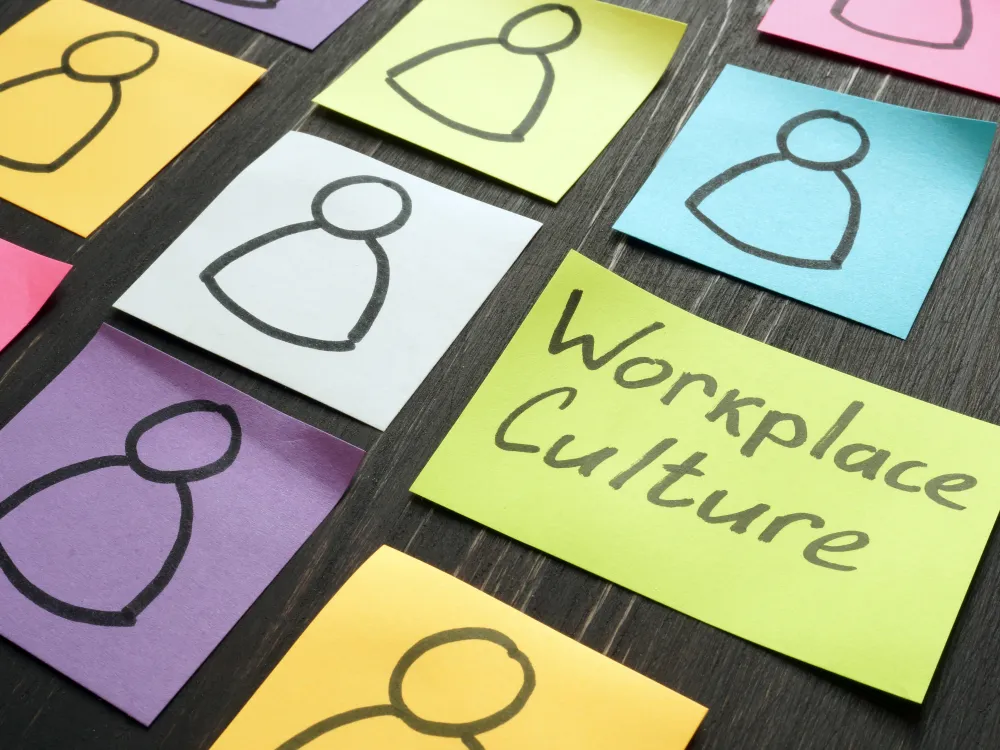
Colorful sticky notes with stick figure drawings and one note stating "Workplace Culture" on a wooden surface.
Shifting Workplace Culture Drives Demand For Employee Experience Tools & Services
The societal paradigm shift is indeed affecting the contemporary workplace and fundamentally altering the ways in which employees want to be treated: workplace culture is now very fluid. For one, it seems that the level of employee loyalty to employers has decreased by a fair margin. The average individual switches jobs every few years, remote work is more common, And the younger generations value life-work balance much more than their predecessors. Businesses have started to appreciate that there’s a constructive fit to maintain workplace standards if they want to retain employees. To meet these goals, new business solutions are being offered to help reconceptualize the employee experience.
Why Employee Loyalty is Declining
In the past, job seekers concentrated their attention solely on the firms that offered pensions and other amenities since it was common to remain with one employer for an entire career. Currently, however, this is not the case. Job satisfaction and personal growth became the new normal due to various economic fluctuations, advanced technologies, and the rise of the gig economy.
Younger generations, specifically the millennials and Gen Z, are living proof of this return. Instead, they focus more on acquiring new skills, engaging in relevant activities, and ensure that there is work-life flexibility. If a job doesn’t meet their needs, they don’t hesitate to leave and find something better. For them, work is more like a deal—you give your time and skills, and the company gives you something in return. It’s not about loyalty anymore.
Making Workplace Experience a Priority
With these changes, creating a good workplace experience is now a must for companies. Workplace experience is about everything an employee goes through at work, like the office environment, how leaders treat employees, and whether the company’s values match theirs. A great workplace experience can:
- Make employees feel more engaged and productive.
- Help keep workers from leaving.
- Attract talented people to join the company.
- Improve the company’s reputation as a good place to work.
Tools to Improve Workplace Experience
To make workplaces better, many companies now use special tools and services.
Here are some examples:
1. Employee Engagement Platforms Tools like CultureAmp and Officevibe help companies see how employees feel about their jobs. They use surveys and feedback to find areas to improve and track progress over time.
2. Workplace Analytics Programs like Microsoft Viva Insights look at how employees spend their time and help make work more efficient. This helps both the company and its employees.
3. Mental Health and Wellness Tools Apps like Calm and Headspace give employees ways to deal with stress, like meditation and coaching. These tools help people feel better and more balanced.
4. Communication Tools Platforms like Slack and Zoom make it easier for employees to stay connected, especially if they work from home. These tools help build teamwork and keep everyone on the same page.
5. Optimizing Office Spaces Tools like VergeSense help companies figure out the best way to set up their offices so they are comfortable and encourage collaboration.
Some companies also use platforms like YakTrak, which focus on keeping employees engaged and helping them grow. These tools are helping businesses adjust to what workers want today.
Measuring Success
To know if workplace improvements are working, companies need to measure them. Traditional surveys aren’t enough anymore. New tools use data and feedback to give a better picture of how employees feel. Some common ways to measure this include:
- Employee Net Promoter Score (eNPS): This shows how likely employees are to recommend their workplace.
- Turnover Rates: Tracks how often employees leave and why.
- Productivity Metrics: Measures if workplace changes are helping employees work better.
- Feedback Quality: Checks if employees feel comfortable sharing their opinions.
The Benefits and Challenges
Spending money on workplace experience can pay off. Studies show that happy employees are more productive and less likely to quit. Companies with a good workplace culture often perform better financially too. But there are challenges, like making sure tools work well together and don’t overwhelm employees. Also, every company is different, so what works for one might not work for another.
Conclusion
The work culture is changing and so should companies. It is clear that trends on lack of loyalty among employees indicate that employees units more from their employers. Businesses can retain their most exceptional talent through focusing on their work experience. For once the tools and services targeted towards enhancing employees’ emotions at the workplace are more essential than they have ever been. The companies that start investing in their people right now are definitely the ones going to succeed in the near future.


